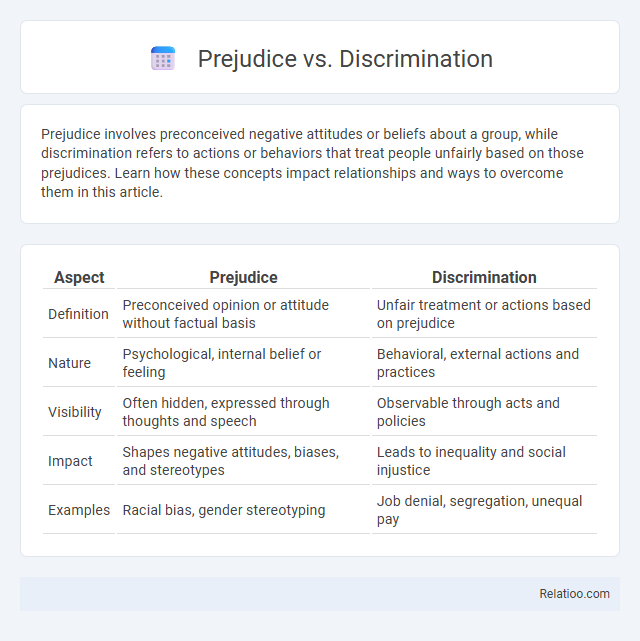Prejudice involves preconceived negative attitudes or beliefs about a group, while discrimination refers to actions or behaviors that treat people unfairly based on those prejudices. Learn how these concepts impact relationships and ways to overcome them in this article.
Table of Comparison
| Aspect | Prejudice | Discrimination |
|---|---|---|
| Definition | Preconceived opinion or attitude without factual basis | Unfair treatment or actions based on prejudice |
| Nature | Psychological, internal belief or feeling | Behavioral, external actions and practices |
| Visibility | Often hidden, expressed through thoughts and speech | Observable through acts and policies |
| Impact | Shapes negative attitudes, biases, and stereotypes | Leads to inequality and social injustice |
| Examples | Racial bias, gender stereotyping | Job denial, segregation, unequal pay |
Understanding Prejudice: Definition and Origins
Prejudice refers to preconceived opinions or attitudes about individuals or groups based on stereotypes rather than actual experience, often rooted in cultural, social, or psychological origins. Discrimination involves actions or behaviors that unfairly treat people differently due to these prejudices, reinforcing social inequalities. Understanding your own biases is crucial for recognizing how prejudice develops and manifests, enabling more conscious efforts to challenge and reduce its impact.
What Is Discrimination? Key Concepts
Discrimination refers to the unjust or prejudicial treatment of individuals or groups based on characteristics such as race, gender, age, or religion, leading to unequal opportunities and outcomes. It involves actions or behaviors that reinforce systemic inequality, differentiating it from prejudice, which is an attitude or belief held internally. Understanding discrimination requires analyzing structural power dynamics and legal frameworks that allow or prevent unequal treatment in social, economic, and political contexts.
Prejudice vs Discrimination: Core Differences
Prejudice refers to preconceived attitudes or beliefs about a group based on stereotypes, often without factual evidence, while discrimination involves actions or behaviors that treat people unfairly based on those prejudiced beliefs. You must understand that prejudice is internal and cognitive, influencing personal mindset, whereas discrimination is external and behavioral, impacting social interactions and opportunities. Recognizing these core differences is crucial for addressing and reducing inequality in various social contexts.
Psychological Roots of Prejudice
Prejudice arises from cognitive biases and social categorization processes that lead individuals to form biased attitudes toward out-groups based on stereotypes and fear. These psychological roots include mechanisms like in-group favoritism, scapegoating, and cognitive dissonance, which perpetuate negative emotions and irrational judgments. Discrimination manifests as behavioral actions stemming from these prejudiced attitudes, resulting in unfair treatment of individuals due to their belonging to stigmatized social groups.
Types of Discrimination in Society
Discrimination manifests in various forms such as racial, gender, age, and socioeconomic discrimination, each impacting individuals differently within a society. Prejudice refers to preconceived opinions or attitudes, while discrimination involves actions or behaviors that treat people unfairly based on those prejudices. Understanding the types of discrimination helps you recognize and challenge social inequalities effectively.
Real-World Examples: Prejudice vs Discrimination
Prejudice involves preconceived attitudes or beliefs about a group, such as assuming all members of a race possess certain negative traits, while discrimination refers to actions that unfairly treat people based on those prejudices, like refusing to hire someone due to their ethnicity. Real-world examples include racial profiling by law enforcement as discrimination, whereas harboring unfounded suspicions about a race is prejudice. Understanding the distinction aids in addressing systemic issues by targeting both biased thoughts and tangible discriminatory behaviors.
The Effects of Prejudice on Individuals
Prejudice generates negative beliefs and attitudes that can lead to discrimination, which involves unfair treatment of individuals based on those biases. The effects of prejudice on individuals often result in psychological harm, including decreased self-esteem, heightened stress, and social exclusion. Your awareness of these impacts is crucial for fostering empathy and promoting social inclusion.
Social and Legal Consequences of Discrimination
Discrimination involves unfair treatment based on prejudiced attitudes, leading to significant social consequences such as exclusion, inequality, and diminished opportunities for affected groups. Legal consequences of discrimination include violations of civil rights laws, resulting in lawsuits, penalties, and mandatory corrective actions to protect individuals from bias. Understanding how your actions may perpetuate discrimination helps address systemic injustice and promotes social equity.
Strategies to Reduce Prejudice and Discrimination
Effective strategies to reduce prejudice and discrimination include intergroup contact, which fosters understanding and breaks down stereotypes by encouraging positive interactions between diverse groups. Educational programs that promote empathy and cultural competence help individuals recognize and challenge their own biases, leading to more inclusive attitudes. Policies enforcing equal opportunities and anti-discrimination laws also play a crucial role in minimizing discriminatory practices in workplaces and communities.
Moving Forward: Building Inclusive Communities
Prejudice involves biased attitudes or beliefs about a group, while discrimination refers to actions that unfairly treat individuals based on those prejudices, with stereotypes serving as oversimplified ideas that fuel both. Moving forward, building inclusive communities requires actively challenging these biases through education, empathy, and equitable policies that promote diversity and respect. Your commitment to understanding and addressing these distinctions fosters environments where everyone feels valued and empowered to contribute.

Infographic: Prejudice vs Discrimination
 relatioo.com
relatioo.com